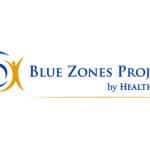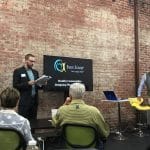Rachel Melot is the director of the local Shawnee team ‘hired to rally the troops.’ Blue Zones, with its national office headquartered in Nashville, has partnered with the Avedis Foundation to encourage Shawnee to become healthier.
Blue Zones Project. Why Shawnee?
We need our help. What can we do to help our lives become healthier, happier and improve our well-being? The idea was first presented in the National Geographic Magazine November 2005 edition ‘The Secrets of a Long Life’ written by Dan Buettner. He discovered there were 5 different areas in the world where people live very long, happy lives.
Rachel Melot is the director of the local Shawnee team ‘hired to rally the troops.’ Blue Zones, with its national office headquartered in Nashville, has partnered with the Avedis Foundation to encourage Shawnee to become healthier. The local focus groups have attracted an unprecedented number of people. Photographer Ed Bolt, staff member, narrated the presentation. He began by asking 7 questions: Do you get 8 hours of sleep 5 nights/week? Do you eat 3 servings of fruits and veggies/day? Do you actively move your body 30 minutes/day? Do you have 3 good friends? Do you participate in a faith-based organization? Have you not smoked the last 5 years or more? Do you desire to live a long life? With 2 yes answers, average length of life for men was 67 and 71 for women. If all 7 questions were answered yes, the age limit for men rose to 88 and 91 in women. 80% of longevity is contributed to lifestyle and environment. Only 20% is genetically controlled.
The 5 confirmed locations where people reach 100 years of age is 10 times the norm found in the US. First Blue Zone is Sardinia, Italy. There is one centenarian alive for every 250 live births versus 1 in 6,000 in the US. The people follow a plant-based diet, but not totally; they eat small portions of meat. Old people are revered in this culture and respected for their sage advice and wisdom.
Okinawa, Japan is another Blue Zone. These people have the longest disability-free life expectancy in the world; 7 years longer than the average US American. They have 1/5th the rate of colon and breast cancer and 1/6th the rate of cardiovascular trouble. The US has 5 times these numbers. Okinawans practice ‘Hara hatchi bu’: eat until you are 80% full. Isolation kills. Twenty years ago people in the US had 3 good friends; the number has now dropped to below 2. Okinawans have close social connections and form support groups called ‘moais.’
Loma Linda, CA has a large concentration of Seventh Day Adventists. One study that included 100,000 people done over several years determined these people live longer due to the focus on family, friends and support groups. They too follow a plant-based diet and have a strong sense of purpose. On their Saturday Sabbath families and friends go together on nature hikes. It helps release stress. Example: the 97 year old doctor built his own garden fence yet still performs some surgeries during the week.
The other two locations are Nicoya Peninsula, Costa Rica and Icaria, Greece.
Recommendations for living a long healthy happy life: move naturally, eat wisely, have a sense of purpose and maintain the right outlook and connectdo choose your friends wisely.
Individual: Think about this: the life radius of an individual (90% of the time) is within 5 miles. Improve your environment, form moais, expand social network, volunteer and find your purpose. Places: stores, workplace, restaurants, schools, Faith organizations. Policy: food, tobacco and built-in environments.
The Blue Zones pilot program was started at Albert Lea, Minnesota in 2009. The town had 18,000 people and abruptly ended at Fountain Lake. Through the help of Blue Zones and AARP, the lake was connected with the town by trails built around the lake. The city restaurants adopted the Vitality Program, offering fruit instead of fries and dropping the bread on the table. Blue Zone Lane shelves were set up in stores to offer healthy options. Many adults made the 10 week commitment and joined moais. It was found that 60% became friends during this time. Over 50% employers participated and a 20% drop in absenteeism was noted; 7280 pounds were lost, 25 million steps taken and the health care needed by city employees went down 40%.
New partnerships were created in beach cities of California. The impressive results caught the attention of the Iowa governor. The impact there took Iowa from #16 to #10 in the healthy state ranking. Let’s not mention Oklahoma right now, but 37 communities in 9 states, 2 million lives, are now improving through Blue Zones Project in action. For each community to see success, it takes initiative and participation.
The big Blue Zones community kick-off for Shawnee will be in August. Visit www.bluezonesproject.com to learn more or contact them. Take the Blue Zones pledge and take action.




